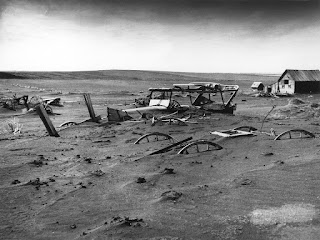The Great Depression/WPA Era 1929 - 1939
Bread lines, soup kitchens and rising numbers of homeless people in America’s towns and cities. Farmers couldn’t afford to harvest their crops, were forced to leave them rotting in the fields while people elsewhere starved. In 1930, severe droughts in the Southern Plains brought high winds and dust from Texas to Nebraska, killing people, livestock and crops. The “Dust Bowl” inspired a mass migration of people from farmland to cities in search of work.
On May 6, 1935, the Works Progress Administration (W.P.A.) was created to help provide economic relief to the citizens of the United States who were suffering through the Great Depression. The artistic community had already become inspired during the 1920s and '30s by the Mexican muralists Diego Rivera, Jose Clemente Orozco, and David Alfaro Siqueiros. Certain visionary U.S. politicians decided to combine the creativity of the new art movements with the values they wanted to reinforce in the American identity. Between 1927 and 1940, Mexico’s three leading muralists—José Clemente Orozco, Diego Rivera, and David Alfaro Siqueiros—came to the United States to execute lithographs and easel paintings, exhibit their art, and create large-scale murals on both the East and West coasts and in Detroit. Their influence would prove decisive for American artists searching for alternatives to European modernism and seeking to connect with a public deeply shaken by the onset of the Great Depression and the economic and social injustices exposed by the collapse of the U.S. stock market. As artist and critic Charmion von Wiegand declared in 1934, Mexican artists were “a more creative influence in American painting than the modernist French masters. . . . They have brought painting back to its vital function in society.” Painter Jackson Pollock was stealing food from pushcarts before he was hired by the WPA's famed murals division - a lot of artists we know learn about and remember were muralists working for the WPA and sustained their exploration and art focus enough to emerge from the Depression and WWII with careers blossoming during the 50's/60's.
** During
the Great Depression, in the early 1930s, the United States deported between
500,000 and 2 million people of Mexican descent (including the illegal
expulsion of up to 1.2 million U.S. citizens) to Mexico (see Mexican
Repatriation), in order to reduce demands on limited American economic
resources. By the late 1930s, about three million Mexican Americans resided in
the United States. Los Angeles had the highest concentration of ethnic Mexicans
outside Mexico. When the Mexicans kicked the Spanish out of Mexico, America changed Mexicans in America from being classified as "White", as they had previously been considered by the government - Mexicans and Mexican Americans were extremely upset over the change, knowing it would result in a loss of basic privileges.
At a time when many Americans felt they had little in common, the WPA assured them of a vital, shared cultural identity through theater, art and music, says Lauren Sklaroff, a history professor at the University of South Carolina. "Many Americans had not ever seen a live play, listened to a symphony that was live, had never visited an art museum," she says. "So the idea behind the federal arts project was to bring art to the masses so that America would have a common lexicon to draw from, in terms what culture meant."
Depression-era hardships had fueled the rise of extremist political movements in various European countries, most notably that of Adolf Hitler’s Nazi regime in Germany. German aggression led war to break out in Europe in 1939, and the WPA turned its attention to strengthening the military infrastructure of the United States, even as the country maintained its neutrality.
Art Assignment:
Transfer the murals we designed last week onto watercolor paper, to begin exploring water-soluble pigment, brush handling, Composition and designing around a Theme or Message (the Theme this time is Communities that we gather in, chosen by each group) - as well as communal manifestations (Teamwork), what it means to be a part of something and work together to explore and define it/communicate about it. Starting to build spaces where students can listen to and respect each other's ideas, and start to weave them together into a larger narrative.

























No comments:
Post a Comment